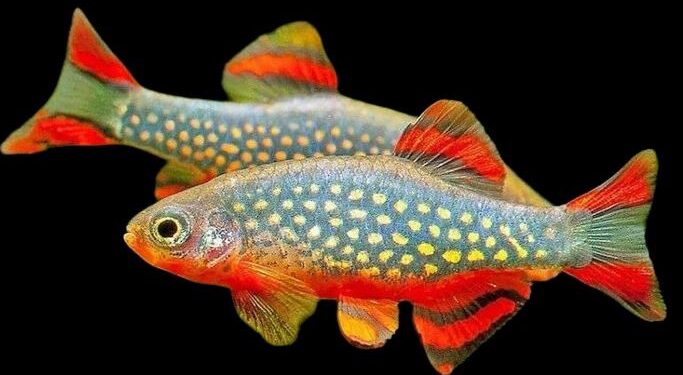Galaxy Rasbora, Galaxy Danios or Celestial Pearl Danios are elegant and beauty-enhancing, small and freshwater fish. Found naturally in the Southeast Asia and can be kept in aquarium. Let’s have a look at the details of its family, size, habitat, eating habits, price and tank mates.
Classification
It belongs to phylum Chordata. Family and class is Cyprinidae and Actinopterygii, respectively.
Size and color
Its size ranges from 0.5 to 2.5 cm to a maximum of 3 cm in size. It is small, vibrant in colours with a blunt snout makes it perfect for keeping in aquariums.
The colors include a blend of Golden spots, black stripings and red to orange fins.
Habitat
It is native to Southeast Asia specifically in Myanmar and also in Northern Thailand. Since 2006, it can typically be kept as aquarium fish also.
Eating habits
Keeping Rasbora in direct daylight with abundant plants would be enough. Being omnivores, some natural plants, water weed, frozen foods and protists are the diet of these fish. A balanced diet along with better water quality can increase its lifespan. However, in the case of water, they prefer it to be acidic to neutral i-e 6-7.0 pH levels.
The water quality impacts on its diet and life. A well-maintained water parameters like nitrate, ammonia and pH levels along with a balanced diet can keep the fish healthy and increase its life.
As the fish is small-sized so feeding them multiple times is recommended.
Reproduction
The average lifespan of Galaxy is 2-4 years, however in some cases they can live up to 5 years depending on the genetics or quality of breed selected for reproduction. A lot of other factors like water quality, temperature, proper nutrition and pH values can affect the lifespan of it.
There is a clear difference among males and females as they show sexual dimorphism.
Males are brightly coloured with high tales and dots on the body. Whereas, females have weaker or muted versions of color patterns.
It produces nearly 30 eggs per spawning period. Eggs are neither free in water nor attached to any surface, rather they are hidden in deep vegetation.
Males usually follow the mating pair and try to add their own sperm or eat the eggs.
On average larvae take 3-4 days to hatch and after 8-10 weeks, metamorphosis occurs and an adult is formed.
Tank mates
Keeping 6 pairs in any tank, aquarium or outside pond are enough with keeping in consideration the water quality, space, nutrition such as natural plants. One thing to follow deliberately is NEVER KEEP THEM WITH LARGE FISH OR BULLY FISH. Some friendly fish like dither and harlequin can be kept with them.
10-20 gallon’s capacity tanks can be used to keep Galaxy Rasbora. As a stress free and well managed environment will ultimately result in the well being of the fish. It prefers a peaceful, spacious with compatible mates and well planted tank.
Price
The price ranges of Galaxy Rasbora from $3-8 for a single fish to $40-80 for a group of 12-16 fish. For further information have a look at Amazon.
Some common diseases of Galaxy Rasbora
Below are some diseases of parasitic, bacterial and fungal origin.
Parasitic diseases
white spot disease(itch) and Velvet disease caused by Oodinium and Ichthyophthirius, respectively.
Symptoms of Velvet disease
- Rusty- dust appearance on body
- Lethargy
- Clamping of fins
Symptoms of itch
- White spots
- Rubbing body against objects
- Rapid gill movement
Fin rot and columnaris caused by poor water quality and Flavobacterium, respectively.
Symptoms of fin rot
- Discolored fins with red or white edges.
Symptoms of columnaris
- Ulcers
- White cotton like growths
- Frayed fins
Furthermore, fungus can cause fluffy white growths on the body of Rasbora.
In addition to micro-organisms, improper diet can also be a cause of disease such as Swim Bladder Disease, in which fish has difficulty in swimming and keeps sinking or floating in water. This disease can also be due to genetic reasons.
Conclusion
Galaxy Rasbora is a small, vibrant coloured shy fish. Which lives up to 2-4 years and gives 30 eggs per spawning time. It is a habitant of Southeast Asia. Keeping them in the tank with proper nutrients, water quality, compatible mates and hygiene is critical and makes them unique. A well maintained tank can lower the stress level and increase the lifespan of the fish. A Galaxy Rasbora increases the beauty of the place where it is kept.
See Also: Brown Trout: A Fascinating Fish of Freshwater Rivers
FAQs:
What is the maximum size of Galaxy Rasbora?
They can reach up to 3 cm in size.
Who should be tank mates of Rasbora?
Gentle and non-violent tank members are preferred as these are shy and always feel harassed.
What is the lifespan of Galaxy Rasbora?
On average they live up to 2-4 years however, if the nutritional factors along with water and cleanliness are considered then they can live up to 5 years.
Temperature for hatching of eggs of Galaxy Rasbora?
It prefers 22-26 Celsius for hatching.
What should be the tank size for Galaxy Rasbora?
10-20 gallons is enough space for fish to move around.




